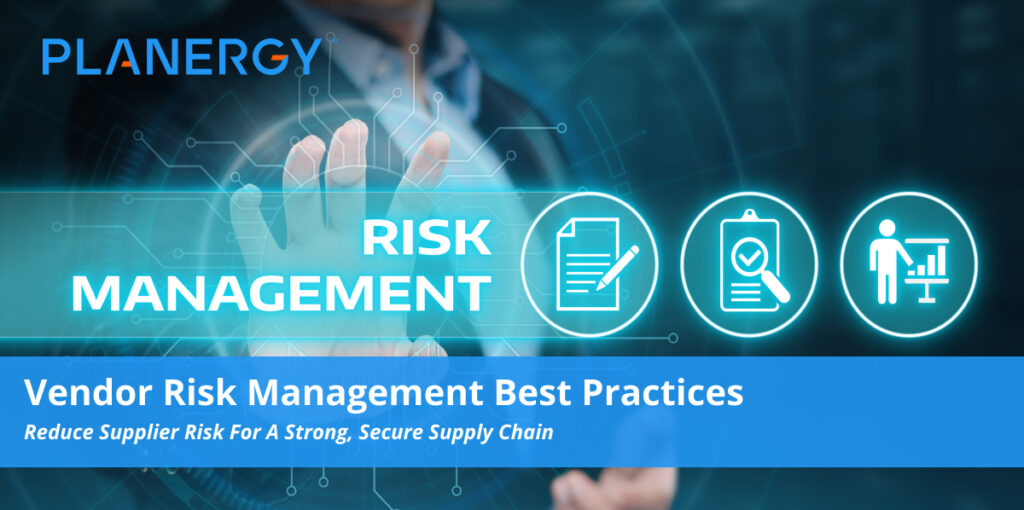Like just about every company, your organization relies upon its suppliers to provide the goods and services you need to do business. But suppliers bring risk as well as reward, and vendor risk management (VRM) is essential for any business who wants to compete in today’s global economy while protecting its financial, operational, and reputational health.
Mitigating these potential risks requires time and care, but doesn’t have to be difficult. By investing in the proper technologies and following some essential best practices for vendor risk management, you can perform your due diligence in order to identify and address threats vendor relationships may pose to business continuity, cybersecurity, supply chain integrity, and more.
Why Having a Vendor Risk Management Program Matters
Large or small, nearly every company who has vendors also has some kind of vendor risk management protocols in place—usually as part of a larger supplier relationship management system. Vendor risk assessment and management tools are becoming increasingly important in a world where supply chains are growing longer and more complex.
Companies (and their business units) are taking advantage of third-party suppliers not only to provide goods and services, but to perform business-critical tasks such as marketing, accounting, and production. These third party suppliers may have third-party suppliers of their own, increasing risk exposure and creating the need for risk management planning that identifies and mitigates third- and fourth-party risk.
Adding to this urgency is the need for comprehensive information security. Guarding against data breaches and leaks to protect both company and customer data is essential to preserving the operational, regulatory, financial, and reputational integrity of a business. Outsourcing core business tasks to service providers can make this process more complex and challenging than ever.
It makes sense, then, to develop and implement vendor risk assessment and management protocols that make it easier to perform continuous monitoring of key performance indicators (KPIs) for vendor compliance, security, performance, and service.
The more readily available such data is, the better a company will be able to vet potential third party vendors, evaluate current ones, and identify and correct vendor risks before they balloon into crises.
If suppliers don’t meet their obligations for quality, performance, service, and delivery, it can create a chain reaction of operational, financial, and reputational devastation.
Potential Vendor Risks
While every supply chain is unique, suppliers bring certain kinds of risk to every business. A few of the potential risks vendors can pose to the health of your business include:
- Legal troubles. Vendors who break the law, violate regulatory requirements, or engage in irresponsible practices can expose your company to lawsuits, loss of valuable certifications and partnerships with government entities, or even the risk of prosecution.
- Data security issues. Companies are increasingly integrating supplier software ecosystems with their own in order to further enhance the benefits that come with centralized data management, automation, and analytics.
However, this integration can increase risk significantly without the proper data security protocols in place to guard against third-party data breaches (including customer data) and bad actors looking to disable or destroy systems or steal intellectual property. - HIPAA violations. Vendors may not comply with the requirements set forth by the Health Insurance Portability and Accountability Act, putting protected health information (PHI) at risk and opening you up to hefty fines and legal action.
- Your good name. Vendors who fail to meet your standards for compliance and performance, or the compliance and regulatory standards set forth by your industry and the law, can cost you more than just government contracts. Suppliers’ unprofessional, unethical, or criminal behavior can taint your reputation with both the buying public and investors, devastating your competitive footing for months or even years to come.
- Competitive strength. If suppliers don’t meet their obligations for quality, performance, service, and delivery, it can create a chain reaction of operational, financial, and reputational devastation.
Best Practices for Vendor Risk Management
Guarding against risk from third-party relationships with suppliers (and the fourth-party relationships you hold with their suppliers) begins with following some basic best practices for due diligence, risk assessment, and crafting an effective third-party risk management program.
- Invest in a Comprehensive Procure-to-Pay (P2P) Solution
Managing vendors effectively is a complex process, from onboarding to ongoing relationship management to advanced negotiations that lead to mutually beneficial partnerships.
But you can’t manage what you can’t see. Implementing a cloud-based, centralized P2P solution like PLANERGY not only gives you full transparency into your spend data, but also allows you to apply tools like automation and analytics to your vendor management workflows to achieve real-time visibility into potential risks posed by new vendors and an effective toolkit for tracking and optimizing performance and compliance from existing vendors.
A best-in-class solution that includes vendor management capabilities can:
- Provide a complete inventory of all your suppliers, highlighting opportunities to reduce supplier bloat (with a focus on high-risk suppliers) while preserving redundancies that protect business continuity and supply chain integrity and providing valuable insights on suppliers who might have the potential to become trusted partners in shared initiatives.
- Allow companies to use data analytics and business intelligence to evaluate potential suppliers and their associated level of risk more effectively during the assessment process—including both third- and fourth-party suppliers.
- Simplify and secure vendor onboarding, including integrations of service level agreements (SLAs) as part of contract management.
- Support secure integration of vendor systems to safely monitor contractual and regulatory compliance, ethical business practices, and overall performance.
- Provide ongoing monitoring of vendor management KPIs in real time, allowing for timely responses to high-risk behaviors and threats.
- Help enforce contract compliance through guided buying and use of vendor punch-out catalogs.
- Provide centralized, secure, and comprehensive data management to reduce cybersecurity risks.
- Support vendor self-assessments as part of a shared commitment to compliance, quality, and performance.
- Create a Dedicated Vendor Risk Management Team
While guarding against needless risk is everyone’s job in a business, a team of experts overseeing vendor risk ensures issues will be identified and dealt with more quickly. This team can also draft, communicate, and enforce policy, ensuring everyone views themselves as a stakeholder in managing vendor risk and complies with internal security controls.
- Formalize Your Vendor Risk Assessment Process
Ideally, your procurement team won’t be adding vendors to your roster “willy-nilly,” but instead onboarding them through approved protocols—beginning with a formal vendor assessment.
It might be as simple as a questionnaire or as complex as a multi-stage, digital onboarding assessment app. This is an area where a top-tier P2P solution with vendor management tools is extremely helpful, as it allows you to generate, distribute, collect, and analyze vendor questionnaires digitally.
This not only streamlines the process, but begins the supplier integration process automatically.
Suppliers whose inherent risk profiles are unacceptable, don’t have a proven track record, or simply don’t meet your standards for compliance and performance can be readily identified and eliminated, while better qualified candidates can be more closely reviewed in a timely fashion.
- Identify and Monitor Vendor Performance Metrics
Cybersecurity strength. HIPAA compliance capabilities. Number of on-time deliveries. Sustainable materials. Whatever the requirements you’ve set for your suppliers, establishing and tracking KPIs will ensure you’re aware of how well they’re meeting—or failing to meet—them.
This is another area where digital tools are a definite advantage in the third-party risk management process. On-demand, real-time monitoring, analysis, and reporting allows senior management and other stakeholders to adjust your supply chain as necessary to guard against reputational, operational, or financial damage.
- Guard against Risk from Fourth-Party Vendors
While you most likely don’t have a formal legal agreement with your suppliers’ vendors, they can still introduce risk into your supply chain and financial/operational ecosystem.
Consider establishing rigorous VRM standards as part of your own supplier requirements; make it clear vendors who meet these standards in assessing, monitoring, and managing their own suppliers will be much more welcome than those who don’t.
The upside is, you’ll reduce your total risk exposure, reduce the need for remediation, and further refine your supplier assessment and onboarding processes to automatically reduce risk by simply eliminating any supplier who doesn’t take a proactive approach to VRM.
- Make Vendor Risk Management Part of Your Business Continuity Planning
From data security to material issues to unethical or illegal behavior, your suppliers can expose you, your partners, and your customers to dangerous levels of risk. And in doing so, they can threaten the very existence of your business itself. Vendor risk management is inextricably linked to disaster response and recovery, and should be treated accordingly.
To protect business continuity, ensure your VRM program has contingencies in place to immediately remove and replace any supplier that fails to meet your standards and creates unacceptable levels of risk in doing so.
Don’t Wait to Invest in Effective Vendor Risk Management
Don’t let your supply chain carry excess risk to your door along with goods and services. Follow best practices for vendor risk management and invest in digital tools to help you optimize your workflows and improve supplier relationships. With a proactive approach to identifying, analyzing, and mitigating risk from third and fourth parties, you can focus on building value for your business instead of wondering whether disaster lies just around the corner.




